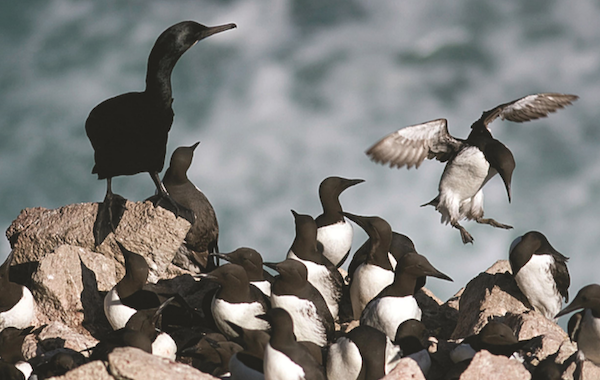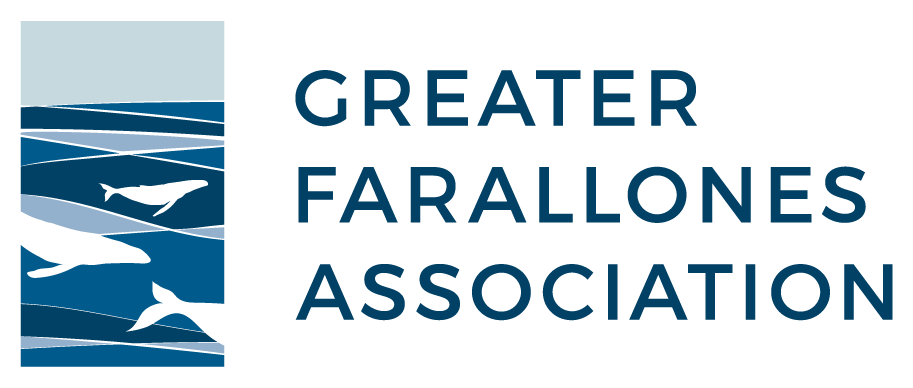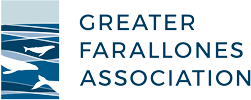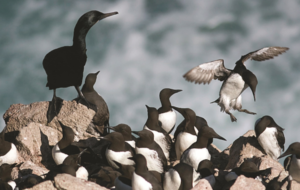Planes, Boats, and Birds During the COVID-19 Pandemic

Seabirds are “all-terrain”—they occupy land, air, and sea. So do humans, and disturbances from boats and planes threaten coastal birds that nest on offshore rocks and cliffs, travel by air, and hunt at sea.
But what happens when the world comes to a screeching halt? During the COVID-19 pandemic in 2020, people flocked to the California coast for fresh air and COVID-safe recreation. Did increased coastal boat and plane activity lead to increased disturbance to seabirds? And did pivoting to online pilot and boater outreach impact our ability to keep those disturbances at bay? A recent presentation from our Seabird Protection Network staff and partners from the Common Murre Restoration Project sheds some light.
Seabird Protection Network (SPN) is a collaborative program of Greater Farallones and Cordell Bank National Marine Sanctuaries (Sanctuaries), Greater Farallones Association (Association), U.S. Fish and Wildlife Service (Service), and Cal Poly Humboldt (University). The Service and University monitor the colonies, while Sanctuaries and Association staff utilize monitoring information in outreach and education campaigns. The goal of SPN is to help restore seabird colonies that were damaged by past oil spills through reducing human disturbance. Program staff jointly presented to over 50 attendees of the 8th annual Wildlife Disturbance Symposium this past November on increased aviation and boating-related disturbances to birds during the pandemic, and adapting outreach strategies in response. Attendees included representatives from government agencies and nonprofits that address wildlife disturbance.
University and Service biologists shared insights about two seabird colonies monitored in the Greater Farallones National Marine Sanctuary area: Point Reyes and Devil’s Slide Rock. These are breeding colonies of Common Murres, Brandt’s Cormorants and other seabirds that face persistent human disturbance, and have been the focus of SPN’s restoration efforts. The Service and University monitoring team tracks human impacts at these sites, counting all aircraft flying below 1,000 feet and all watercraft approaching to within 1,500 feet of a nesting area (aka the “detection” zone). If there is evidence of a bird experiencing disturbance from the detection-zone craft, including head bobbing, wing flapping, fleeing, or flushing—they record it.
This information helps guide outreach efforts and evaluate how well they are working. The Sanctuaries and Association team prioritizes outreach to boaters and pilots along the Central Coast. It has built long-term partnerships within these communities by giving regular presentations at kayaking and sailing clubs, pilots associations, regional airports, and the US Coast Guard’s Air Station San Francisco. SPN has partnered with the Federal Aviation Administration (FAA) on trainings that ensure pilots are aware of regulations over national marine sanctuaries. SPN also teaches boaters how to identify seabird colonies along the coast. These long term-partnerships have helped reduce disturbances to seabird colonies.
At the Wildlife Disturbance Symposium, the monitoring team presented information they have collected throughout three key monitoring periods: 2005-2010, the early days of monitoring; 2011-2019, when outreach efforts soared, special closures for boats were implemented (areas where boats are not permitted), and marine protected areas were established (this time period saw declines in disturbances); and then 2020-2022, when the COVID-19 pandemic hit.
Comparing boat traffic and disturbance over time, it was found that during 2020, at the Point Reyes colonies, there was a significant increase in boating traffic. When diving a little deeper, the data showed a slight increase in boats entering nearby special closure areas designed to protect the seabird colony; this went back to normal in 2021. The increase could be attributed to a rise in inexperienced boaters on the water who may not be as privy to closures and seabird-safe rules. The good news is that there was not a corresponding rise in seabird disturbances. Generally speaking, boaters steered clear of the cliffs when around Point Reyes. Similar trends were seen for boating traffic at Devil’s Slide Rock, and we’re hopeful that ongoing boater outreach at these two sites continues to allow nearby nesting birds to enjoy a disturbance-free home.
The air traffic at Devil’s Slide tells a different story. Monitoring team data show that aircraft activity increased in 2020—along with aviation-related disturbances. However, this trend actually started before the pandemic, as Devil’s Slide Rock is a high traffic area. This area is not listed as a sensitive nesting area on aeronautical charts – so outreach to pilots is a high priority for SPN.
For the Seabird Protection Network, boaters and pilots are partners in seabird conservation. In a typical year, connecting with boaters and pilots means seeing friendly faces at air shows and boating events, handing out informational materials dock-side or while attending events hosted by our partners at the FAA, and giving in-person presentations to partners. During the pandemic, SPN pivoted to virtual presentations that allowed staff to reach exponentially more people in more places. However, the pandemic limited efforts distribute materials and make meaningful, in-person connections with partners.
Now that SPN is able to once again share seabird-safe messages in the field, staff is returning to in-person opportunities to connect with boaters and pilots, while continuing to give online presentations. Biologists continue to carefully track disturbances, which helps answer whether outreach efforts are leading to decreased disturbances at seabird colonies.
SPN has a busy year ahead with plans to launch an outreach campaign for boat-based fishermen, and expand efforts to reach out to pilots. In April, staff will return to the Pacific Coast Dream Machines air show in Half Moon Bay, which was canceled for the past three years. Staff will see old friends, and make new ones at the dozens of air shows, harbors and tackle shops they will visit.
To learn more about how to protect seabirds when you’re on the water or up in the air, visit the Seabird Protection Network website, and to keep up with egg-citing seabird news, sign up to receive Seabird Protection Network’s e-newsletters.
Photo credit: Ron LeValley (Common Murres)


